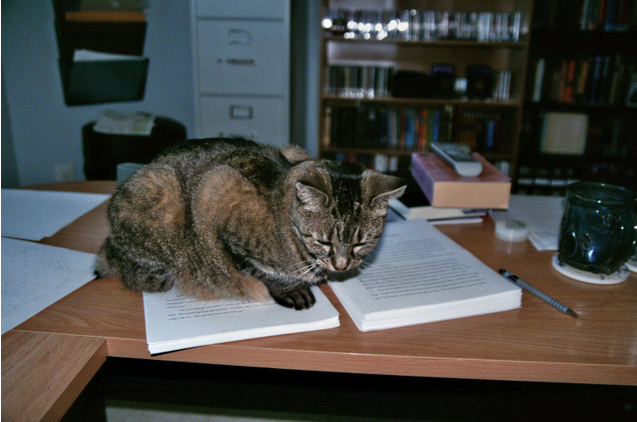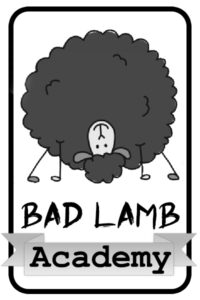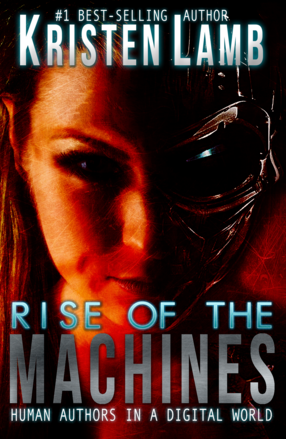Welcome to Structure Part 8. We have spent the past few weeks studying the fundamentals of what makes up a novel, and today we are going to discuss the actual scenes that make up a novel and how to keep track of them. It is easy to get lost when dealing with a structure as complex as a novel, so I hope to give you a nifty tool to keep everything straight.
As a fiction author, you will often feel like an acrobat spinning plates while standing on your head and juggling fiery chainsaws. There are so many components to keep track of, lest you end up down the Bunny Trail of No Return. Organization is key when it comes to being a successful novelist.
First, let’s talk about scenes.
According to James Scott Bell’s Plot & Structure, scenes do four things. Bell calls these the four chords of fiction:
The two major chords are: (1) action and (2) reaction.
The two minor chords are (1) setup and (2) deepening.
Back when I used to content edit, I was known to draw cute little cartoon flies on the page when the story took off down a bunny trail and lost my interest. This became known as my, “Fly on the Wall of ‘Who Cares?’” and was a signal to the writer that this was a section with no real purpose so it needed revision, tightening or to be cut completely. The reader is a fly on the wall when it comes to the world we are creating. Make them the fly on the wall of something interesting at all times.
How do we accomplish this?
All Scenes Need Conflict
Conflict is the fuel that powers the story’s forward momentum. “Scenes” that are merely back-story, reflection (rehash of what the reader already knows) or information dump, slow down the story and make the reader either want to skim ahead or put the book down. Bad juju. We want our readers hooked from the beginning until we finally let them go on the last page. How do we accomplish this? We add lots of conflict.
Scenes, according to Bell, need three components, collectively known as HIP—Hook, Intensity & Prompt.
Hook—interests the reader from the get-go. This is why it is generally a bad idea to start scenes with setting. Waxing rhapsodic about the fall color is a tough way to hook a reader. If you do start a scene with setting, then make it do double-duty. Setting can set up the inner mood of a character before we even meet him. Setting should always be more than a weather report. Try harder.
Intensity—raises the stakes. Introduce a problem. Scenes that suddenly shift into reverse and dump back-story KILL your intensity. Cut scenes at meals unless there is a fight. If your characters are in a car, they better be in an argument or a car chase. Also cut any scenes that the sole purpose is to give information. Have a scene that’s sole purpose is two characters talking about a third? CUT! CUT! CUT!
We are writing novels, not screenplays for Days of Our Lives.
Prompt—leave the scene with work left undone and questions left unanswered. If your character is relaxed enough to happily go to bed at the end of a scene, that is a subconscious cue to your reader that it is okay to mark the page and close the book. There should always be something unsettling that makes the reader want to know more.
Going back to the chords of the writing. Every scene should involve one of your key characters in pursuit of an interesting goal that is related to the overall conflict of the story. Each of these scenes are stepping stones that take your character closer to the final showdown. Most of the time, it will feel like two steps forward and one step back.
Your POV character (protagonist) sets out to do X but then Y gets in the way. Your character then will have some kind of a reaction to the setback.
So we have the major chords I mentioned earlier:
ACTION–> REACTION to the obstacle
Now when we add in the minor chords, it might look something like this:
Setup–>ACTION–>obstacle–>REACTION to the obstacle–>deepening
Setup and deepening need to be short and sweet. Why? Because they don’t drive the story, conflict does. We as readers will need a certain amount of setup to get oriented in what is happening, but then drive forward and get to the good stuff. Deepening is the same. We want to know how this conflict has changed the course of events, but don’t get carried away or you risk losing your reader.
Every scene should have conflict and a great way to test this is to do a Conflict Lock. Bob Mayer teaches this tactic in his workshops and if you get a chance to take one of his classes, you will be amazed how your writing will improve.
The conflict lock is a basic diagram of what the conflicting goals in the scene look like. Here is one from one of my earlier fiction pieces. My protagonist’s roommate has just been taken by bad guys, and protag and the love interest are clearly in conflict:
Jane wants to pursue the trail of the kidnappers deeper into Mexico.
Tank wants to return to Texas and call the FBI.
Even though these two characters are allies, it is clear they want different things. Jane wants to plunge ahead and take her chances pursuing the bad guys who have her friend. The love interest doesn’t want Jane hurt or killed. He wants to take the safer route and let the pros handle the kidnapping. Both have reasonable goals, but only one of them, by the end of the scene, will get his/her way. One path takes Jane closer to finding her roommate. The other ends the adventure.
So how do you keep track of all these elements? The note card is a writer’s best friend. We will discuss different methods of plotting in the future, but I recommend doing note cards ahead of time and then again after the fact. I stole a very cool tactic from screenwriter Blake Snyder’s Save the Cat.
On each note card, I write the location, then a one-sentence header about what the scene is about. Then there is a neat little symbol for conflict (><) I use to show who is in conflict in this particular scene. Then I do a micro conflict lock. Who wants what? I also use an emotional symbol to note change +/-.
Characters should be changing emotionally. If your protag enters on a high note, crush it. Enters on a low? Give some hope. If a character is constantly okey dokey, that’s boring. Conversely, if a character is always in the dumps, it will wear out your reader and stall the plot. I also note any facts I might need to keep up with. Has my main character suffered an injury? Lost her weapon? Gained a bazooka and a pet hamster?
Let’s look at an example from the movies. Romancing the Stone.
So the card might look something like this:
Jungles of South America (Location)
>< Joan (protag) and Jack (love interest/antagonist)
Joan wants a guide to get her to Cartejena, Columbia to trade the treasure map for her sister.
Jack wants to recapture the exotic birds he lost when the bus crashed into the back of his truck.
-/+ Joan finally convinces Jack to take her to Cartejena. (Note she started on a low. She was lost, in a crash and far away from Cartejena. She ends on a high note. Jack agrees to guide her to her destination)
Joan and Jack decide to go to Cartejena (decision), but then bad guys arrive and start shooting at them (prompt).
Yes, Blake Snyder’s system is designed to keep up with all the scenes a movie, but it can do wonders for novelists, too. When I finish my first draft, I go back and make set of cards. Using this system makes it painfully clear what scenes are in need of a total overhaul. If I can’t say in one sentence what the scene is about, then I know my goal is weak, nonexistent or unclear. Too many people in conflict? Conflict might be muddy. Go back and clarify. If there isn’t any emotional change, then that’s a big red flag that nothing is happening–it’s a “Fly on the Wall of ‘Who Cares?'”
If I find a scene that’s sole purpose is information dump, what do I do? I have three choices. 1) Cut the scene totally. 2) Fold it into another scene that has existing conflict. 3) Add conflict. Note cards also make it easy to spot bunny trails—goals that have nothing to do with the A or B plot.
This tactic can help make a large work manageable. If you are starting out and outlining? Make note cards for each scene and who you foresee being in conflict. If you already have your novel written, but you want to tighten the writing or diagnose a problem you just can’t see? Make note cards.
Keeping organized with note cards is an excellent way to spot problems and even make big changes without unraveling the rest of the plot. There are, of course, other methods, but this is the one I have liked the best. Note cards are cheap, portable and easy to color code. For instance, each POV character can have a designated color. Using these cards makes it much easier to juggle all the different elements of great novels—characters, conflict, inner arc, plot, details.
Have any questions? Are there other methods that have worked for you? Please share so we all can learn. What is the biggest challenge you face when it comes to plotting?
I love hearing from you! (Contest details below)
Quick Announcement. CLASS IS TOMORROW!: Have trouble putting down and enforcing boundaries with yourself? With family? Always putting everyone else ahead of yourself? I am teaching a new class called Good Fences–The Writer’s Guide to Setting Boundaries and it is only $15 so I hope you will take advantage. This class is perfect for those who want to do Nanowrimo. I’ll help you learn the Art of the Loving NO.
***Class fee does not apply to meth-addicted howler monkey with a sidearm to guard your office door.
Anyway, again, I LOVE HEARING FROM YOU!
To prove it and show my love, for the month of October, everyone who leaves a comment I will put your name in a hat. If you comment and link back to my blog on your blog, you get your name in the hat twice. If you leave a comment, and link back to my blog, and mention my book We Are Not Alone in your blog…you get your name in the hat THREE times. What do you win? The unvarnished truth from yours truly.
I will pick a winner once a month and it will be a critique of the first 20 pages of your novel, or your query letter, or your synopsis (5 pages or less).
And also, winners have a limited time to claim the prize, because what’s happening is there are actually quite a few people who never claim the critique, so I never know if the spam folder ate it or to look for it and then people miss out. I will also give my corporate e-mail to insure we connect and I will only have a week to return the 20 page edit.
At the end of October I will pick a winner for the monthly prize. Good luck!
I also hope you pick up copies of my best-selling books We Are Not Alone–The Writer’s Guide to Social Media and Are You There, Blog? It’s Me, Writer . And both are recommended by the hottest agents and biggest authors in the biz. My methods teach you how to make building your author platform FUN. Build a platform and still have time left to write great books.









20 comments
13 pings
Skip to comment form
Kristen, this series is so helpful, except now I have so much to do/redo on the novel. (joking). I have a pile of index cards staring at me, all in pretty colors that appeal to my inner magpie. Thank you!
I always enjoy reading your blog, it is very helpful to me in becoming a better writer. 🙂
“Setup and deepening need to be short and sweet.”
Oy.
I am starting to think I don’t do anything short and sweet. 😉
Great post to remind me to keep it simple.
I love this! I have just started using note cards to organize my nonfiction books as well as my fiction. Your scene set up is another piece of the puzzle. Thanks!
I have my scenes in Excel (also easily reorganized and colorized), but you’ve given me some additional bits to think about here. 🙂
You chose a great time to write this series of posts, did you do it just for me?? I’ve already regurgitated so much of what you’ve taught me through your books and blog to others…ok, maybe that was a gross verb to use, but still, I’m spreading the word of WANA. 🙂 http://abharmsbooks.blogspot.com/2012/10/80-of-us-want-to-write-book-so-why.html
Tnx for a helpful series of posts.
Great suggestions as usual. Thanks!
Good stuff, for sure. I believe I will use the note cards in the editing process my next time around.
I wonder though- I have written certain scenes that I really do need, but that may not comply with the formula outlined above. They aren’t dry or bad, and they are needed. They aren’t info dump or anything either. They are what I would call “setup”, moving a few key things into place so that later scenes will be improved (and more plausible), and payoffs at the end will be more gratifying. It also seems like, without a scene like this here and there, that I would be badly glossing over something that needs at least *some* mention in order to weave the tapestry without gaping holes.
I think I will go back to a few I have in mind, and compare it to the model, and see if they have more to them than I think. I know character arcs of secondary characters is something that gets short shrift a lot, but when its relevant to the character arc of the primary characters, I have to give these elements their due. I don’t think these scenes are boring or “who cares?” but they aren’t as compelling as the major scenes, by nature.
In the future, I will see if I can spice up these secondary scenes that I need, to make them as interesting as possible, though I think I do pretty well with them as it is.
thanks Kristen!
I’ve gone through a number of times, noting what happens in each chapter, but this system with the note cards takes it that one step further. I really think this is the refinement I need to use next. Where would I be without you, Kristen!
I have to admit I haven’t really read the article. I just wanted to react to the picture. My cat does the same thing, he always sits on my paperwork! I’m considering renaming him to “paperweight”. 😛
Reading these posts about structure makes me feel excited about my writing. I’m actually feeling like it might work out really well if I take your advice. I’m all ready for nano now! Thanks, nano angel, 😉
Kristen,
I use a loose leaf notebook and will write a synopsis of each scene or chapter as I write. I also make a diagram (on a long sheet of paper) using different colors for each character. I draw lines with arrows that indicate proximity to one another as the story progresses. I draw bubbles with notes in them at appropriate places in the timeline to describe the conflict and other elements that are important. This visual reference makes it easy to hold everything together as I write. but I think your card idea has a lot of merit. More flexible then a notebook. Thanks for the tips.
My cat is famous!! *faints*
Seriously, though. This structure series has been amazingly awesome. Everything seems so obvious after you’ve explained it!
What a serendiptious post! The worsd “balance” figures heavily into the title of my first fictional piece! it must be Fate that has drawn me to you, young lady…
Excellent advice, as well. Thank you.
Kristen, every single post you write has helped me in some way. Now all I have to do is get 50,000 words done for nanowrimo… Thank you though. I’m a huge fan!
Great exercise. My notecards are virtual, with scrivener. I’ve got a high-level note for each scene (multiple scenes per chapter) but the added bits aren’t there. Excellent tips to clean up a first draft (especially if you’re keeping them in back of mind while writing the first draft).
I like the note card method. Unfortunately, I will not be able to do the note cards before NaMoWriMo tomorrow, but I will note card the draft at the end of the month.
Excellent post Kristen, made sure to take notes, and looking forward to applying them. Absolutely true about organzization which we work on constantly. We’ve found using poster boards, for time-lines, as well as character bios when we’re b.p., helps, so our writing room walls are covered in poster boards with stickems next to them. Thank you so much for the post and we will be putting out tweets recommending other writers read this.
This was jam-packed with many take-aways, thank you for making this series.
[…] Structure Part 8–Balancing the Scenes that Make Up Your Novel « Kristen Lamb’s Blog. […]
[…] Kristen Lamb – Structure Part 8 […]
[…] Structure Part 8–Balancing the Scenes that Make Up Your Novel. […]
[…] Structure Part 8: Balancing the Scenes That Make Up Your Novel by Kristen Lamb […]
[…] As a fiction author, you will often feel like an acrobat spinning plates while standing on your head and juggling fiery chainsaws. There are so many components to keep track of, lest you end up down the Bunny Trail of No Return. Organization is key when it comes to being a successful novelist. […]
[…] Structure Part 8–Balancing the Scenes that Make Up Your Novel […]
[…] Lamb wraps up her structure series with how to balance your scenes. Roz Morris explains why the oft-quoted “write what you know” does not have to contrain you or […]
[…] Structure Part 8—Balancing the Scenes That Make Up Your Novel by Kristen Lamb at Kristen Lamb’s Blog […]
[…] Balancing the Scenes That Make Up Your Novel by Kristen Lamb. […]
[…] for writing romance. Balancing the scenes: Kristen Lamb continues her series about structure with a discussion of scene. Put your best blog forward: August McLaughlin discusses how and when to make changes to your blog. […]
[…] From Kristen Lamb – Structure Part 8 – Balancing the Scenes That Make Up Your Novel. […]
[…] Tips for Creating a Compelling Novel by Jody Hedlund Structure Part 8 – Balancing the Scenes that Make Up Your Novel by Kristen Lamb My Favorite Points of View – Guest Post by Bill Hopkins on Mystery Writing is […]
[2]
Structure Part 8-Balancing the Scenes that Make Up Your Novel | Kristen Lamb’s Blog